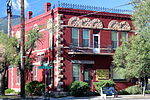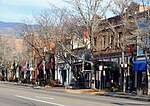Fairview Cemetery (Colorado Springs, Colorado)
1895 establishments in ColoradoBuildings and structures in Colorado Springs, Colorado

Fairview Cemetery is a 32-acre cemetery owned by the city of Colorado Springs, Colorado. A cemetery for area pioneers, the cemetery was founded in 1895 on the west side of the city, but there were earlier burials on the land. The land was donated by Anthony Bott in exchange for water rights. Bott was a founder of Colorado City, now known as Old Colorado City. It offers views of Garden of the Gods and Cheyenne Mountain. Buried in the cemetery are Anthony Bott, madam Laura Bell McDaniel, Civil War veterans, gold prospectors, and saloon keepers. There are up to 15,000 remains buried in the cemetery.
Excerpt from the Wikipedia article Fairview Cemetery (Colorado Springs, Colorado) (License: CC BY-SA 3.0, Authors, Images).Fairview Cemetery (Colorado Springs, Colorado)
Howbert Street, Colorado Springs
Geographical coordinates (GPS) Address Nearby Places Show on map
Geographical coordinates (GPS)
| Latitude | Longitude |
|---|---|
| N 38.841447222222 ° | E -104.87198888889 ° |
Address
Howbert Street
Howbert Street
80904 Colorado Springs
Colorado, United States
Open on Google Maps










